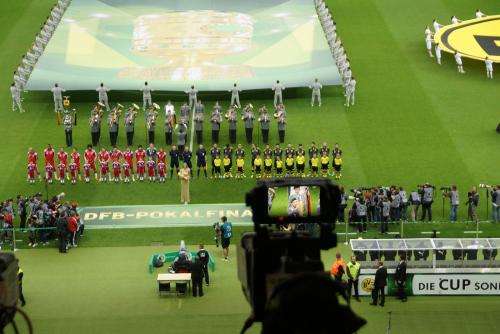Razor-sharp TV pictures

The future of movie, sports and concert broadcasting lies in 4K definition, which will bring cinema quality TV viewing into people's homes. 4K Ultra HD has four times as many pixels as today's Full HD. And thanks to the new HEVC video compression standard, broadcasters can now transmit live video in the 4K digital cinema standard. From September 12 to 16, 2014, Fraunhofer researchers will be presenting latest hardware and software for high efficiency video encoding and decoding at the International Broadcasting Convention IBC in Amsterdam, Netherlands (Hall 8, Booth B80).
A few months ago the broadcaster Sky achieved a world first by transmitting a Bundesliga scoccer game live in 4K definition – the current digital cinema standard. With its 3840 x 2160 resolution, 4K provides four times as many pixels as today's Full HD TV resolution. Higher resolutions inevitably creates more than four times the data volumes of standard HD, so the broadcaster used the new HEVC video compression standard to transmit the huge amount of data. HEVC, short for High Efficiency Video Coding, was developed by major electronics manufacturers together with researchers from the Fraunhofer Institute for Telecommunications, Heinrich-Hertz-Institut, HHI. The key advantage of HEVC is that it requires only half the bitrate of its predecessor H.264 to provide the same picture quality – allowing it to transmit twice as much data on the same channel. This means that HEVC is practically made for the ultra-high definition of 4K television.
Live coding of 4K images with HEVC
The video compression technique was used for the game between FC Bayern Munich and SV Werder Bremen held in the Allianz Arena on April 26, 2014. The live coding of the 4K camera images from the stadium enabled the successful application of the technique developed by the HHI researchers together with their colleagues at Rohde & Schwarz. The HHI´s software and hardware solutions convert the camera images into a coded HEVC bitstream, which is then transmitted to televisions via satellite. Benjamin Bross, who heads up the HEVC project at the HHI, explains why this process is so special: "For the first time, we were able to encode 4K recordings live."
This type of real-time encoding throws up numerous challenges. While the previous standard, H.264, divides the image to be transmitted into blocks of 16 x 16 pixels, HEVC subdivides using variable block sizes. The encoder must therefore decide which block sizes make the most sense on an image-by-image basis. The HHI researchers will be demonstrating the complete HEVC processing chain at the IBC trade fair.
Right down to the smallest detail…
So far, so good. But how will viewers benefit from being able to watch 4K content with HEVC coding in their living rooms? The biggest plus is undoubtedly the astonishing level of detail in the razor-sharp picture. In a scoccer match, for example, one camera can capture the entire playing field. That gives viewers at home a strategic overview while still allowing them to make out every last detail. The first 4K televisions are already on the market, and web streaming services are starting to offer content in ultra HD resolution – so the 4K evening news is sure to be coming soon!
Provided by Fraunhofer-Gesellschaft

















